HVAC business valuations: Current market prices & deal data 2025
Looking to buy or sell an HVAC business? Our guide breaks down current market values (3-6x+ EBITDA) and connects you with active buyers and expert advisors.
In this guide
Whether you’re a business owner planning your exit or an investor seeking opportunities, we’ll help you navigate the HVAC M&A landscape with confidence.
Why HVAC companies are in high demand now
HVAC companies are hot targets. The market’s growing fast—projected to double in the next decade—driven by energy upgrades, smart tech, and aging buildings.
Buyers love recurring service revenue and the steady demand created by new efficiency and refrigerant regulations. The industry’s still fragmented, so PE firms and strategics are rolling up smaller players, just like we saw in dental and vet sectors.
M&A deals are up nearly 7% year-over-year, with more buyers chasing fewer quality companies, pushing prices higher.
Bottom line: strong growth, regulatory tailwinds, and fierce buyer competition make this a seller’s market for HVAC.
Recurring revenue models
Service agreement businesses commanding premium valuations
Energy efficiency regulations
Driving equipment replacements and upgrades
Baby boomer retirement wave
Many HVAC business owners are 55+ and planning exits
Axial HVAC market activity & deal flow
Recent HVAC Transactions

Current market snapshot
156 HVAC businesses actively seeking buyers through Axial’s advisor network, representing $1.5B in combined revenue and ranging from $2m to $107M in annual sales, and $500k to $13m in EBITDA.
Active deal profile
EBITDA range
min
$500K
median
$1.8M
max
$13M
Revenue range
min
$2M
median
$5.8M
max
$107M

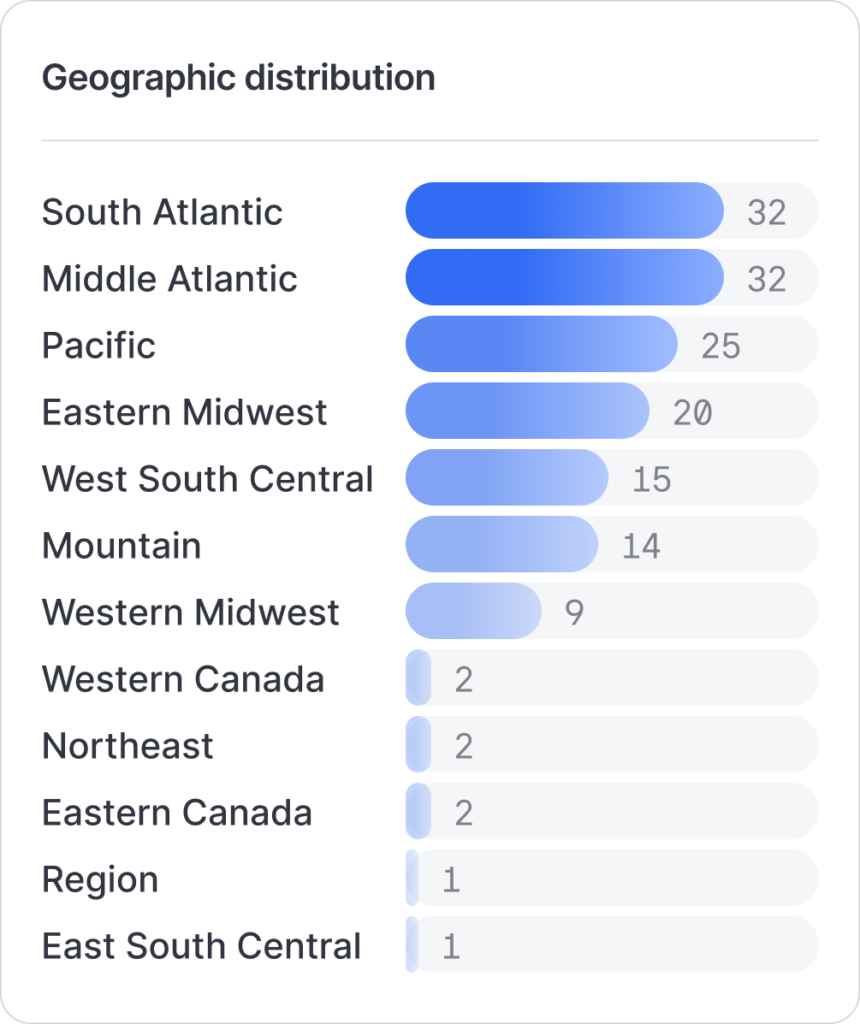
Deal performance metrics
HVAC businesses marketed through Axial generate strong buyer interest, with the average listing receiving 24 buyer pursuits. Most competitive processes move from initial marketing to Letter of Intent within 4.5 months.
2023-2025
recent transaction activity
19
completed transactions
$360k - $7m
EBITDA range
$1m - $87m
revenue range
2.1x - 15.8x
multiple range
97%
represented by an advisor
Buyer mix
6 PE-backed, 4 strategic, 2 family office
7.7 months
average time to close
Buyer demand trends
The HVAC sector continues attracting significant acquisition interest, with 81 buyer pursuits in Q1 2025 compared to 47 in Q2 2024 – representing 72% growth in buyer activity over three quarters.
Who's buying HVAC companies
HVAC buyers

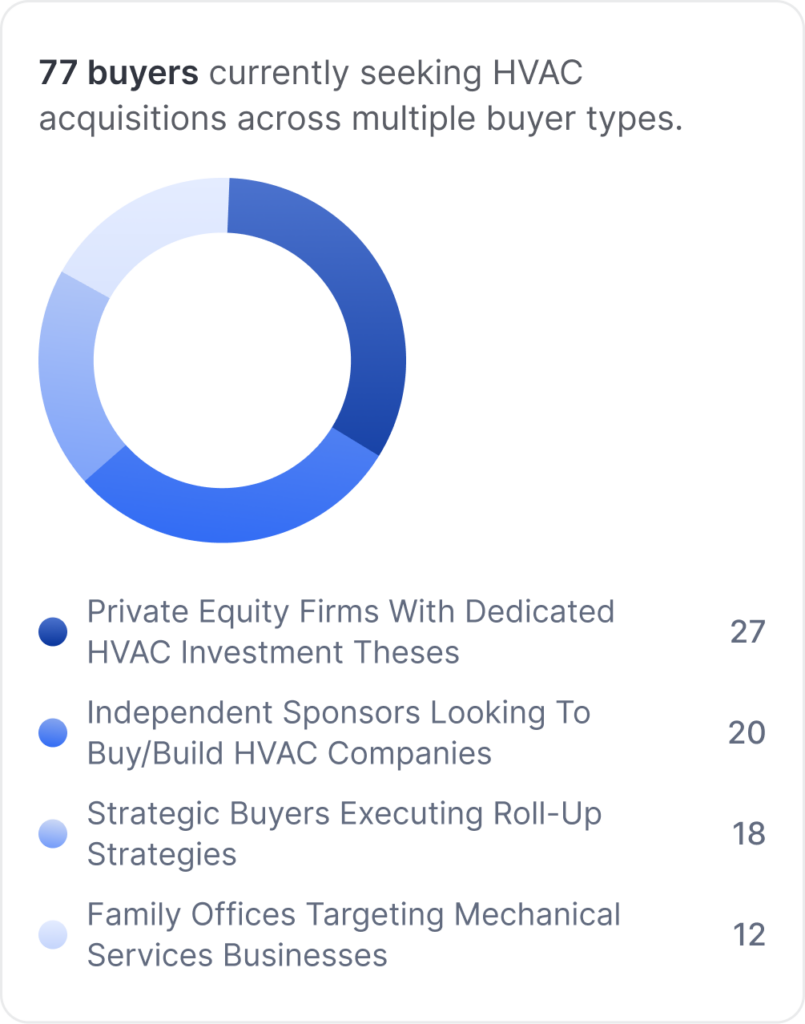
Activity trends
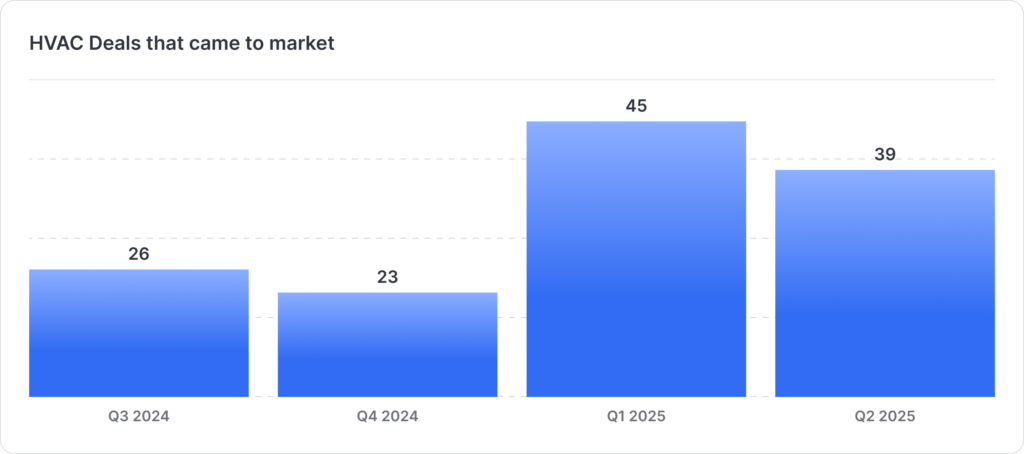
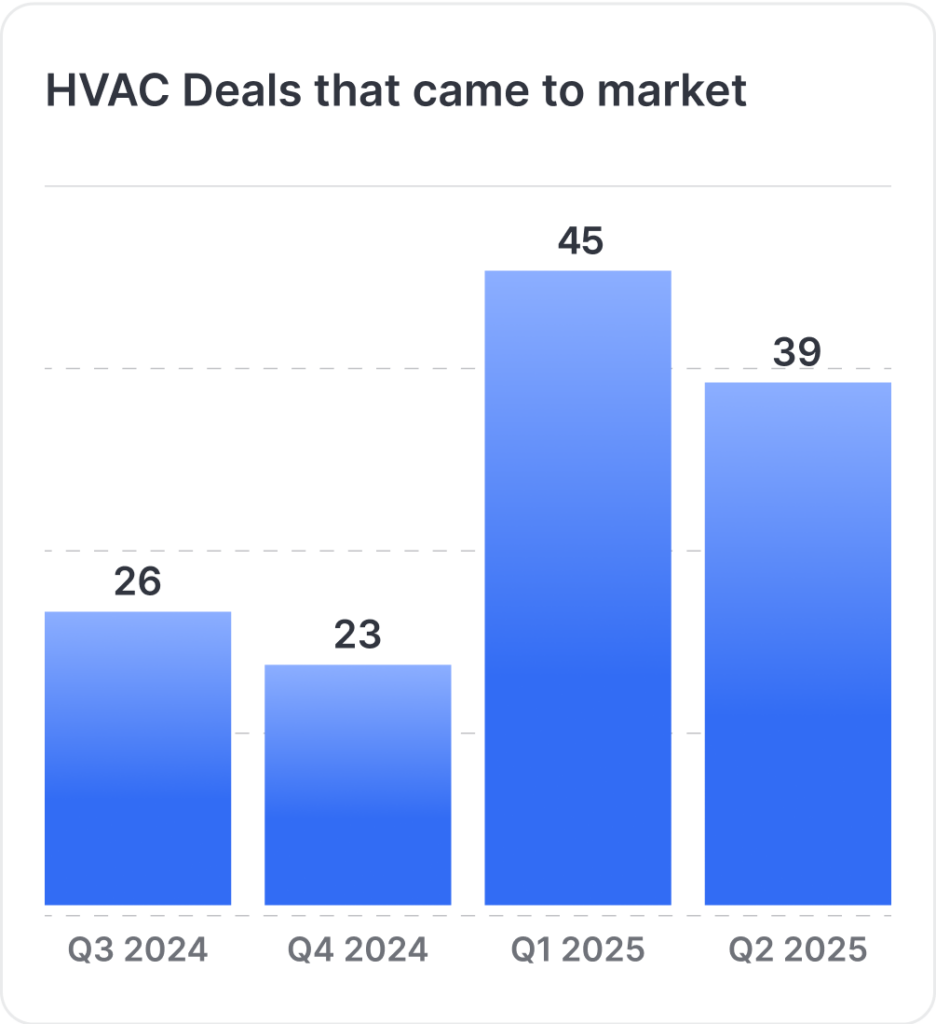
Types of HVAC business buyers
Each buyer type has different priorities when acquiring HVAC companies.
Independent sponsor and private equity firms
Primary focus
Growth
Key interests
- Service contract revenue
- Management continuity
- Growth potential
- Looking for a “Platform” that can acquire other, smaller businesses in the same industry.
Deal structure
Often retain owner for 2-3 years, typically 70-80% cash at close
Family offices, holding companies, search funds
Primary focus
Stable, cash flow businesses
Key interests
- Long term orientation
- Owner transition plan
- Brand reputation
- Low customer concentration
Deal structure
More flexible terms, longer hold periods, sometimes seller financing
Corporations (strategics)
Primary focus
Geographic expansion, customer base acquisition
Key interests
- Technician retention
- Cross-selling opportunities
- Operational synergies
Deal structure
Higher upfront cash percentage, potential for strategic premium
Connect with specialized M&A advisors
Find the right advisor to maximize your exit value
After submitting, you’ll receive a call from our Exit Consultant within 24 hours to discuss your advisor finding options.
Case Study
How Core Mechanical's owners achieved their perfect exit
From Initial Consideration to Successful Close: A 12-Month Journey
The owner's story
Company
Core Mechanical Inc.
Location
Chicago, IL
Business
Commercial HVAC, plumbing and mechanical maintenance services
Markets Served
PreK-12 schools, colleges, airports, healthcare institutions, churches, park districts
The Decision
After years of building their business, the owners of Core Mechanical were ready to begin their retirement process. They had developed strong operational leadership and wanted to find a buyer who would support continued growth while allowing them to transition out.
The process results
Buyer Interest Generated
375 potential buyers
identified as matches for Core Mechanical's profile
292 buyers
received the opportunity through targeted outreach
38 buyers
actively pursued the deal (13% pursuit rate)
Multiple competitive offers
received from different buyer types
Buyer competition by type & pursuits

Why the winning buyer was perfect
"Core Mechanical hit all of the key points we look for in acquisitions – the right market, the right customer mix, and the right management team to continue to lead. We will continue to enable. Core to grow by leveraging our shared services, our other brands in the Chicagoland market, and continue to provide the necessary capital to support growth on larger contracts."
Phil Lynch, Managing Director, Amalgam Capital
The Timeline
From marketing to close
October
Core Mechanical came to market through Axial
October following year
Transaction successfully closed (12 months total)
October
Targeted outreach to qualified buyer pool begins
May
Letter of Intent executed with Amalgam Capital (6 months)
October
Core Mechanical came to market through Axial
October following year
Transaction successfully closed (12 months total)
October
Targeted outreach to qualified buyer pool begins
May
Letter of Intent executed with Amalgam Capital (6 months)
What made this exit successful
Competitive process
38 interested buyers created pricing tension
Right buyer match
Found buyer committed to growth and retaining management
Clean transition
Operational leadership remained in place
Growth capital
Buyer provided resources for larger contract capabilities
Market expertise
Buyer had existing Chicago presence and industry knowledge
The advisor's role
Gary Rakan of Vesticor Advisors represented Core Mechanical throughout the process:

Gary Rakan
- Used Axial's platform to identify and reach qualified buyers
- Managed competitive process with 38 pursuing buyers
- Guided owners through 12-month transaction timeline
- Secured optimal outcome with committed growth partner
Vesticor Advisors
Axial member since 2013 with offices in Ohio, Michigan, and Florida
Ready to explore your HVAC business exit options?
This case demonstrates how our advisor matching process helps you find the right partner who can generate significant buyer interest (38 pursuits from 375 qualified prospects) – an advisor who truly values your market position, customer relationships, and management team.
Key factors that drive HVAC business value
This is a list of the key factors investors will use to evaluate your business:
Factor
Drives valuation higher
Drives valuation lower
Revenue Growth Rate
High and consistent revenue growth
Declining or inconsistent revenue
Profit Margins
(EBITDA or SDE)
Strong profit margins
Low profit margins, high operational
Recurring revenue
(Service contracts)
More recurring revenue from service contracts
Few or no service contracts (one- time project – based jobs)
Customer base
(commercial vs. residential)
Commercial contracts (higher margins, stability)
Heavy reliance on residential customers
Growth rate
Faster growth = higher multiple
Multi-year growth trend more important than single year
Geographic market & demand
Growing market with high HVAC demand
Low demand or saturated market
Brand reputation & online reviews
Strong brand, high online ratings and referrals
Poor reputation, bad reviews, low referrals
Dependence on owner
(owner involvement)
Business runs smoothly without owner dependence
Low demand or saturated market
Employee & technician retention
Skilled and certified technicians, low turnover, strong training programs
High employee turnover, lack of certifications, difficulty hiring technicians
Technology & efficiency in operations
Automated scheduling, CRM, efficient inventory
Inefficient operations, outdated technology
Licenses & certifications
Proper licensing, compliance with regulations (HVAC contractor licenses at state and local levels, insurance to cover liabilities)
Lack of proper licenses or compliance issues
Age & condition of equipment/fleet
Well-maintained equipment & modern fleet
Old, outdated, or poorly maintained equipment
Market competition & differentiation
Strong differentiation, unique value proposition (financing options, customer service, smart home integration, automation)
No differentiation, high competition
Economic conditions
(housing & construction market)
Booming housing and commercial construction sector
Slow housing/construction market
Regulatory & environmental compliance
Fully compliant with regulations regarding energy efficiency and environmental standards (e.g., transitioning to eco-friendly refrigerants), no legal risks
Regulatory issues, risk of fines or shutdown
Seasonality & revenue stability
Year-round revenue, diversified services (maintenance contracts, commercial HVAC, plumbing, or electrical services)
Highly seasonal, revenue fluctuations
Exit process & finding an advisor
The HVAC Business Exit Process
Total timeline
Most HVAC businesses take 9-12 months from initial valuation to completed sale. Well-prepared businesses with clean financials and strong management teams typically sell faster.
Most critical stage
Advisor selection – increases average sale price by 25% vs. owner-led process
Pro Tip
For businesses with $5M+ revenue, conducting a voluntary financial review or audit before going to market can significantly increase buyer confidence, reduce due diligence time, and potentially increase valuation multiples.
1. Initial Preparation
Basic financial organization and business documentation
2. Advisor Selection
Research and hire M&A advisor with experience in your industry
3. Professional Valuation
Comprehensive business valuation conducted by your advisor
4. Advanced Preparation
Basic financial organization and business documentation
5. Marketing Process
Develop materials, confidential outreach to buyers
6. Negotiations Initial offers
LOI evaluation and selection
7. Due Diligence
Buyer verification of all business aspects
8. Closing
Final negotiations and transaction completion
Exit Preparation for HVAC Business Owners
Buyers pay premium multiples for well-prepared HVAC businesses. Focus on these areas 6-12 months before going to market
Preparation area
Key actions
Impact on sale
Service contracts
Document all agreements, renewal rates, and pricing history
Demonstrates recurring revenue stability
Technician team
Implement retention incentives and document certifications
Addresses buyer concern about talent flight
Customer diversification
Reduce dependency on top customers below XX%
Lowers perceived business risk
Financial clean-up
Separate personal/business expenses; normalize financials
Simplifies due diligence process
Equipment/fleet
Update asset list with maintenance records and valuations
Validates capital expense projections
Licensing/permits
Ensure all certifications are current and transferable
Prevents closing delays
Operational documentation
Facilitates smoother transition
Document processes, pricing models, and vendor relationships
Finding the Right HVAC M&A advisor
Based on Axial data, the right advisor can help you find 10x more qualified buyers, get you a 25% higher price, is 75% more likely to complete a transaction than going it alone, and saves owners around 15+ hours per week in dealing with potential buyers.
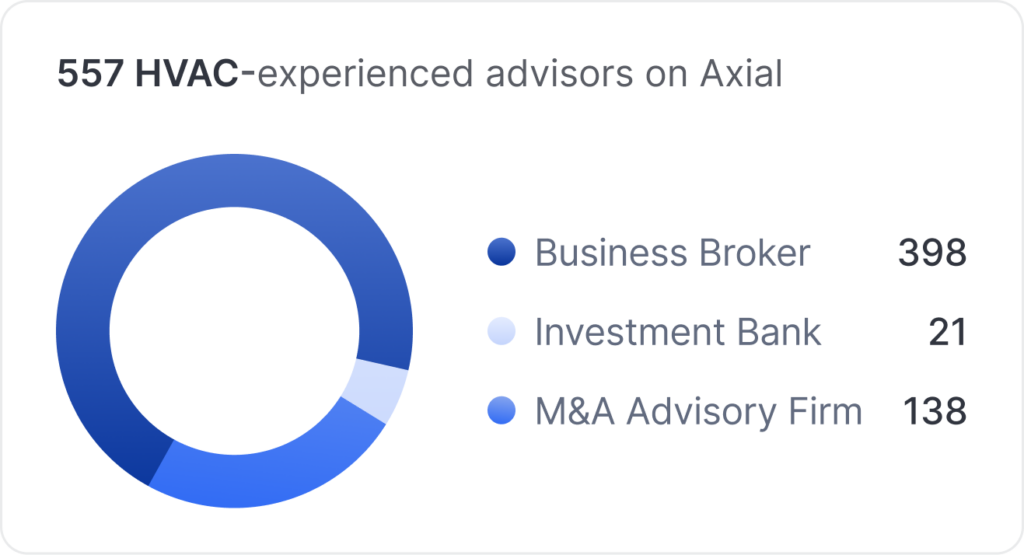
Business brokers
Best for
Companies with $1M-$5M revenue
- Handle straightforward sales to individual buyers or small companies
- Business sells for a stated price
- Work like real estate agents - lists your business publicly and finds buyers
Fees
Typically 8-12% of sale price, paid at closing
M&A advisors
Best for
Companies with $5M-$50M revenue
- Run private, professional sale processes with multiple buyers competing
- Buyers submit bids for your business
- Specialize in your industry and know the right buyers
Fees
Usually 5-8% of sale price, some require small upfront retainer
Investment banks
Best for
Companies with $25M+ revenue
- Full-service teams with deep industry expertise
- Buyers submit bids for your business
- Access to institutional buyers and complex deal structures
Fees
Typically 3-5% of sale price plus monthly retainer fees
The Bottom Line
Higher fees often mean higher sale prices. A good advisor pays for themselves. Think of it like hiring a lawyer. You can use your neighbor who dabbles in business law, or hire the specialist who lives and breathes your type of case. The 5% you pay a quality M&A advisor often gets you 25% more money than going it alone.
Connect with specialized M&A advisors
Find the right advisor to maximize your exit value
After submitting, you’ll receive a call from our Exit Consultant within 24 hours to discuss your advisor finding options.
HVAC M&A FAQ
Focus on cleaning financial statements, documenting service agreements, ensuring transferable licenses, and building a management team that will remain post-sale.
3-5 years of financial statements, customer contracts, employee agreements, equipment lists, real estate information, and vendor relationships.
From initial preparation to closing, the average HVAC business transaction takes 5–8 months, with service-heavy businesses typically selling faster than installation-focused companies.
Service revenue (especially under contract) can increase multiples over installation-heavy businesses due to predictable cash flow.
Strategic buyers typically pay 0.5–1.0x higher multiples but may consolidate operations. Financial buyers generally preserve company identity and retain management.